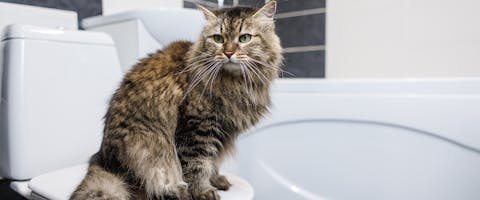Considering whether to train your cat to use the toilet? Find the pros and cons of cat toilet training below.
Pros of cat toilet training
There are a few perceived benefits that make toilet training your cat attractive to some pet parents, such as:
1. Avoiding litter box cleaning
With your cat using the toilet, you can say goodbye to the daily task of scooping and cleaning a litter tray. For busy pet parents, this can save valuable time and make day-to-day life a little easier.
2. It can help reduce the smell in your home
A toilet-trained cat eliminates the issues of stray litter and lingering odors. Without a litter box, your home may smell fresher, especially in small spaces. This potential perk is one of the main reasons some pet parents consider cat toilet training.
3. It reduces the space a litter tray takes up
Litter trays can take up valuable floor space, which isn’t ideal in smaller apartments or homes! Using a cat potty training seat instead frees up that area.
Trending posts
Purr-use some of the top blogs our members have been loving this month- Top male dog names for your new furry friendGot a new furry family member in your pack? Check…

- Top female dog names for your new fluffy palWelcoming a new pooch into your family? Explore…

- 250+ gray cat names your silver feline will loveRecently welcomed a fluffy gray bundle of joy into…

- What are normal pet sitting rates?Discover the average pet sitting rates for animals…

- Unique dog names to stand out from the packDare to be different with our list of the best…

Cons of cat toilet training
Before you commit to a cat toilet bowl trainer, explore the reasons why training your cat to use the toilet might not be a good idea.
1. You could miss the symptoms of a medical problem
Your cat’s waste can reveal a lot about their health. Changes like diarrhea, blood, or irregularities in the litter box often signal potential health issues. If your cat is using a toilet, you’re far less likely to notice these warning signs in time to take action.
2. Your cat might fall into the toilet
Toilets aren’t designed for cats - a slip or fall into the water can be frightening, and even cause injury. A single bad experience might leave your cat scared of using the toilet, creating accidents and stress for both of you.
3. It may result in a stressed cat
Cats thrive on routines and natural instincts, like scratching, digging, and covering their waste. These are all ingrained habits that help cats feel secure, and toilet training removes these behaviors, which can result in unnecessary anxiety or behavioral problems, such as refusing to go to the bathroom altogether.
4. They have to assume an uncomfortable position
Balancing on a slippery toilet seat isn’t natural for cats! This awkward posture can lead to accidents and discourage them from using the toilet, especially if they feel unstable or unsafe.
5. A toilet-trained cat can't travel
A toilet-trained cat might struggle to adapt when faced with a litter box if they need to travel - this can result in accidents and added stress for your pet in unfamiliar surroundings.
6. The toilet must always be accessible
Unlike a litter box, which can be placed anywhere, a toilet-trained cat has only one option. If the bathroom is occupied or inaccessible, your cat could end up with no place to go, leading to messy accidents.
6. It could cause other issues around your home
For some cats, the toilet may become less of a tool and more of a toy. They might flush the toilet out of curiosity or treat the water bowl as an extra play spot, leading to wasted water or hygiene concerns.
Key takeaways:
- Cat toilet training can eliminate litter box chores but comes with risks and drawbacks.
- Toilet training cats can cause stress and make it hard to monitor their health.
- Alternatives like automatic litter boxes provide a more practical solution.
- Cats are instinctively programmed to dig, scratch, and bury their waste. Training your cat to use the toilet interrupts these natural behaviors and may create unnecessary stress.
Alternatives to cat toilet training
Rather than teaching your cat to use the toilet, consider these alternatives that cater to your cat’s instincts and ensure their comfort.
Litter box training
Training your cat to consistently use a litter box is the simplest and most effective option. Choose a location that’s quiet and easy for your cat to access, and keep the box clean to encourage use. Explore litter options that suit your cat’s preferences, such as unscented or clumping varieties.
Related article: How to set up your cat's litter box
Automatic litter boxes
For those who want to minimize scooping, automatic litter boxes can help. These high-tech solutions clean themselves after each use, keeping the area tidy and reducing odors. Popular models include features like odor control and multi-cat compatibility, making them a convenient option for busy households.
Access to nature’s toilet
If you have an outdoor space, allowing your cat access to a secure garden or yard lets them use natural surfaces like soil or sand, which aligns with their instincts. This option provides mental stimulation and mimics their wild behaviors, but it does have its drawbacks. For one thing, you may not be able to keep a close eye on your kitty's bathroom habits and monitor for potential changes.
Keep your cat happy and stress-free with the right care options. Learn how TrustedHousesitters connects you with pet-loving sitters who prioritize your cat’s comfort below.
Finding a sitter
Cat toilet training FAQs
Is toilet training a cat a good idea?
No, it’s not ideal for your cat’s well-being. While it might simplify your routine, toilet training cats can stress your cat and interfere with their natural behaviors.
Can a cat be trained to flush the toilet?
Some cats can be trained to flush the toilet, but it’s not recommended. Flushing out of curiosity can lead to wasted water or plumbing issues.
Is it possible to train a cat to use the toilet?
Yes, many cats can be trained to use the toilet with patience and the right method. However, not all cats adapt well, and success depends on the cat’s personality, age, and behavior.
What should I do if my cat refuses to use the toilet during training?
Stop training your cat to use the toilet if they refuse or show signs of distress. Forcing the behavior can lead to accidents or behavioral issues like inappropriate elimination.

